2009 VOLKSWAGEN GOLF warning
[x] Cancel search: warningPage 134 of 516
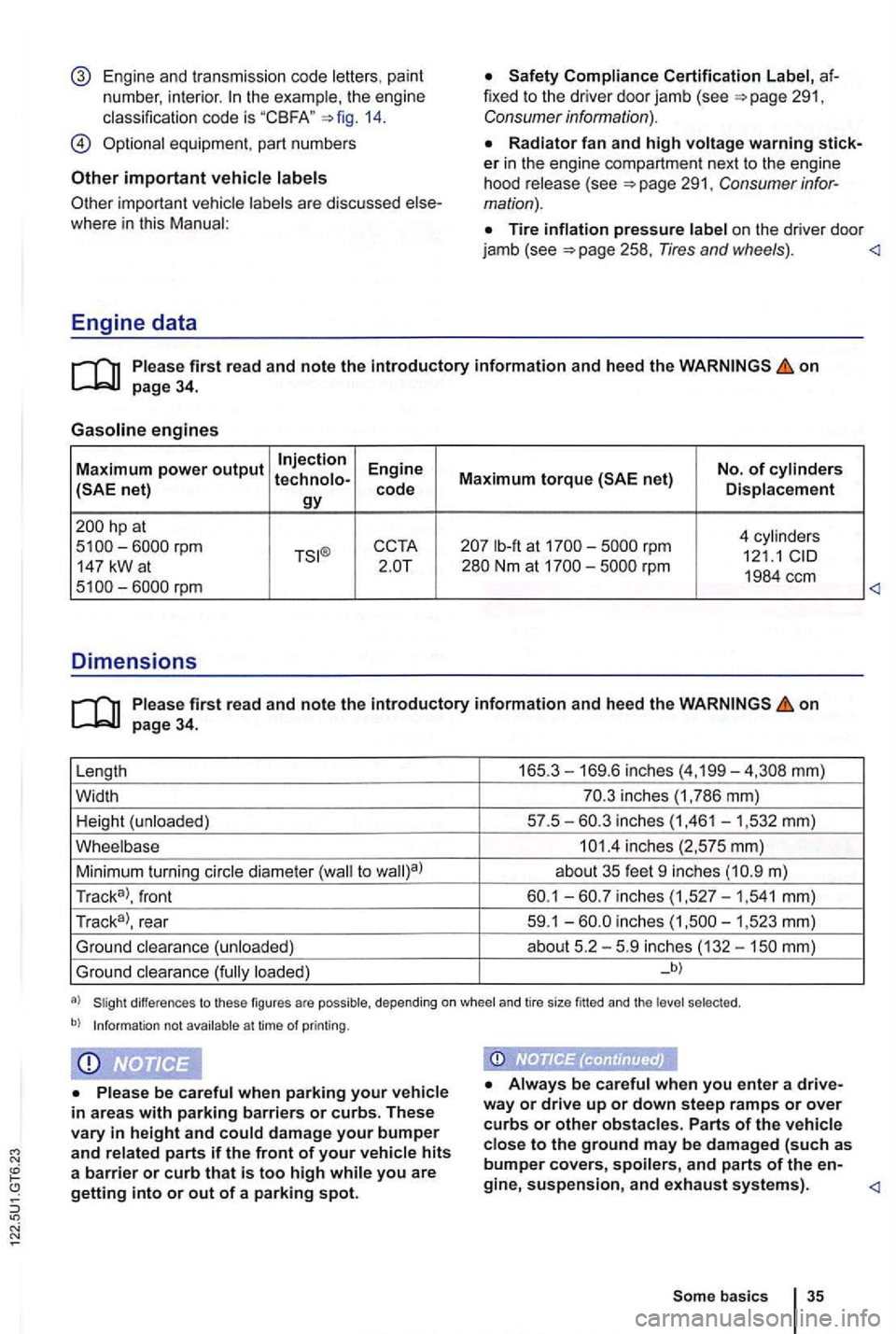
Engine and transmiss ion code letters , pain t
numbe r, interio r.
14.
important vehicle
Radiator fan and high voltage warning sticker in the engine compartment next to th e engine
hood re lease (see
Tire inflation pressure la bel on the drive r door
jamb (see
Engine data
on page 34.
Gasoline engines
Maximum power output Injection Engine No. of cylinders
hp at
4 cy lin d er s lb-ft at rpm 121.1 147 kW a t
on page 34.
Length 165 .
3-169.6 inches (4,199-
m)
Tr ac k
a>, front
inches
loaded) _b)
differences to these figures are possible, depending on whee l and tire size fitted and the selec ted .
b) Informat ion not avail able a t time of printing .
Always be careful when you enter a drive
way or drive up or down stee p ramps or over curbs or other obstacle s. Parts of the vehicle close to the ground may be dam ag ed (such as bumper covers, spoilers, and parts of the en-
Page 146 of 516
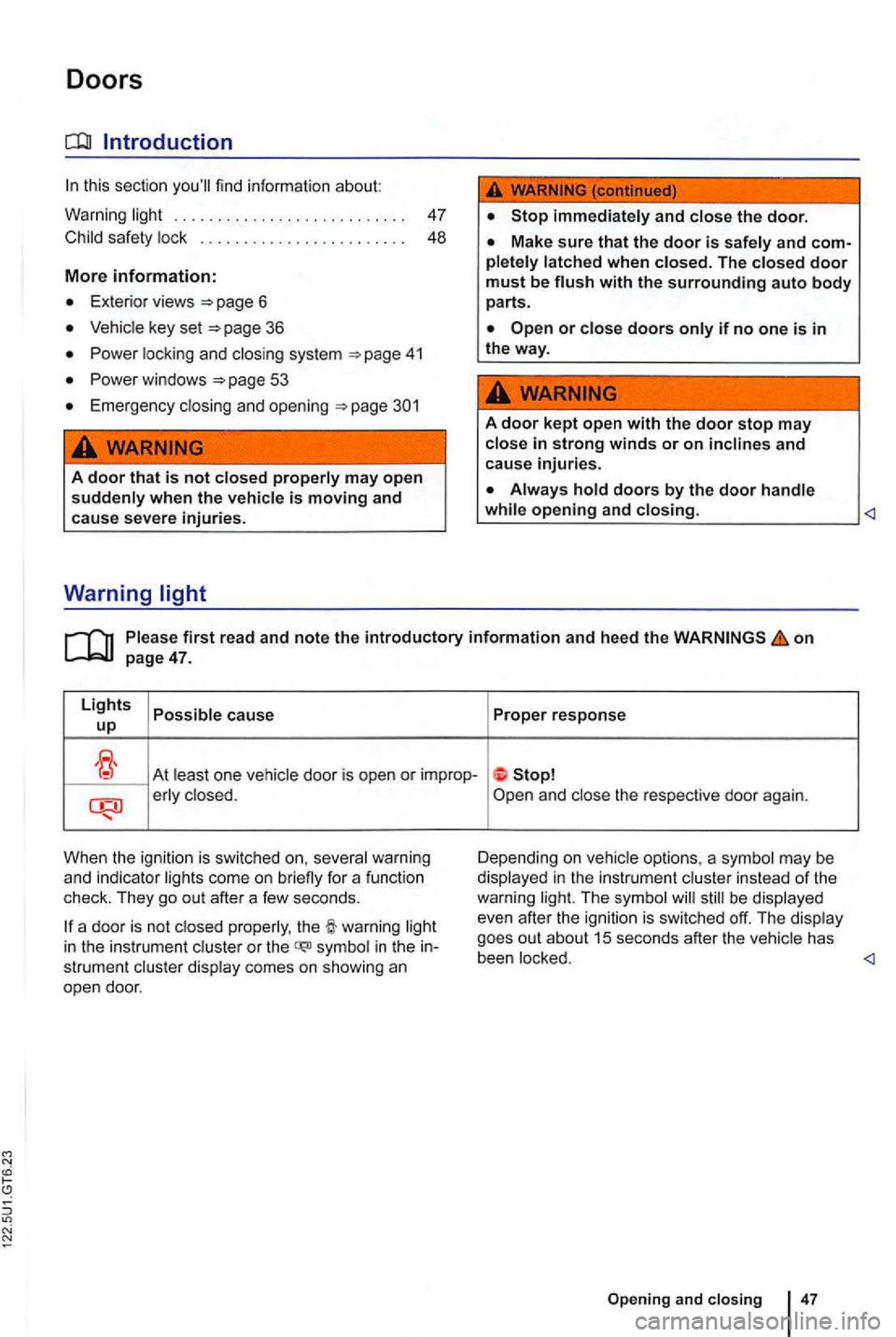
Doors
. . . . . . . . . . . . . . . . . . . . . . . . . . . 47
Child
saf ety lock . . . . . . . . . . . . . . . . . . . . . . . . 48
More information:
Exterior views 6
Vehicle key set
Power loc king and closing sys tem
Power windows
Emergency clo sing an d opening
...
A door that is not closed properly may open suddenly when the vehicle is moving and cause severe injuries.
Warning
A door kept open with the door stop may
close in strong winds or on inclines and cause injuries.
on
At least on e vehicle door is open or improp-erly clo sed.
When the ignition is swi tc h
ed on, several warning
and indi cato r lig hts come on briefly for a function
check. They go out after a few seconds.
be displayed
even after the ignition is swi tched off. The display
goes out about
15 seconds after the vehicle has
in the instrument cluster or the symbol in the strument cluste r display comes on showing an
open door. been locked.
47
Page 148 of 516
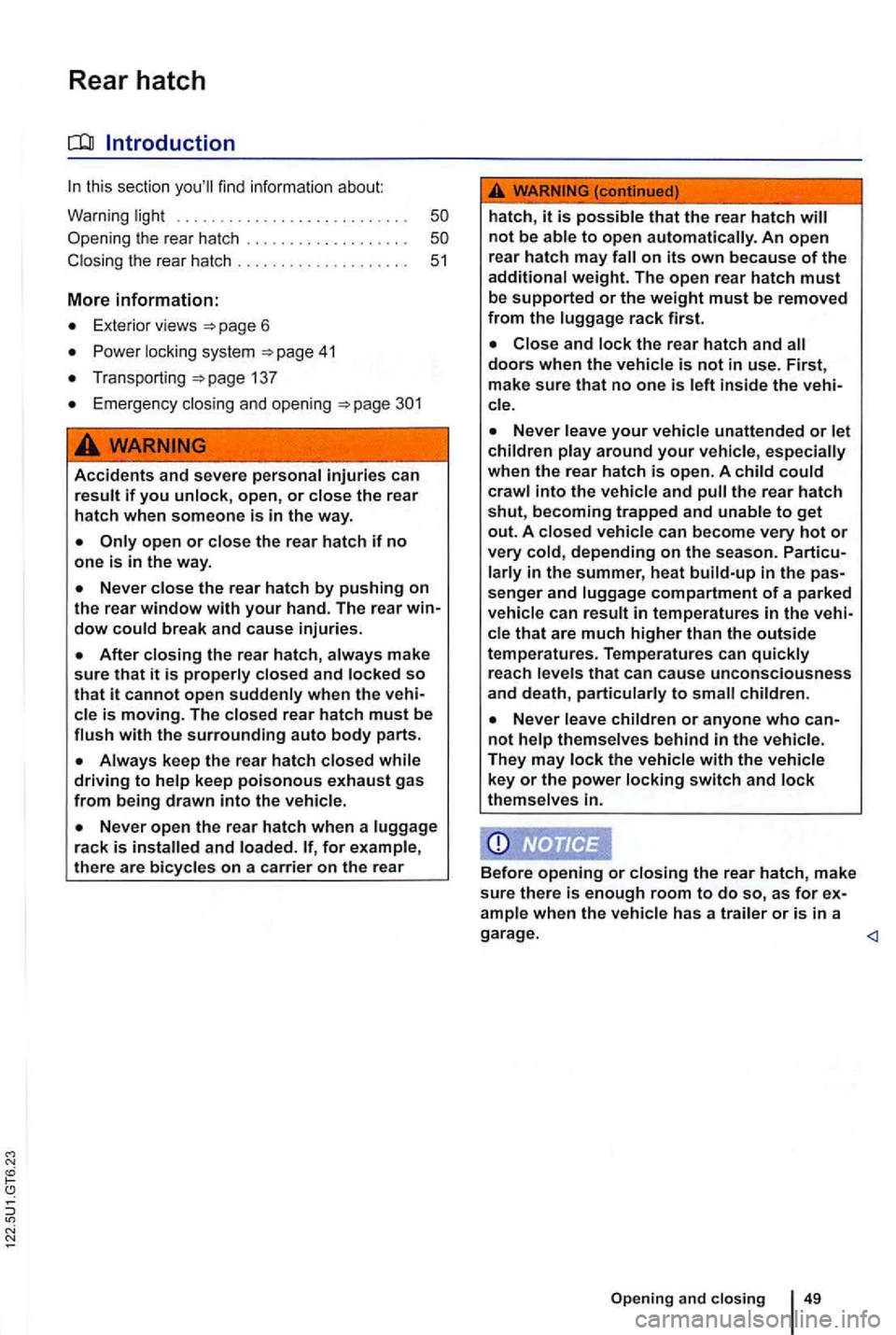
Rear hatch
this section find information about:
Warning
. . . . . . . . . . . . . . . . . .
the rear hatc h . . . . . . . . . . . . . . . . . . .
Exterior views
Power locking system
Transporting
Emergency closing and open ing
Accidents and severe personal injuries can if you unlock, open, or
the rear hatch if no one is in the way.
the rear hatch by pushing on
the rear window with your hand. The rear window
make sure that it is properly closed and locked so that it cannot open suddenly when the vehi
and loaded. for example, there are bicycles on a carrier on the rear
to open automatically. An open rear hatch may
when the rear hatch is open. A into the vehicle and
vehicle can become very hot or very
children or anyone who cannot
and closing
Page 149 of 516
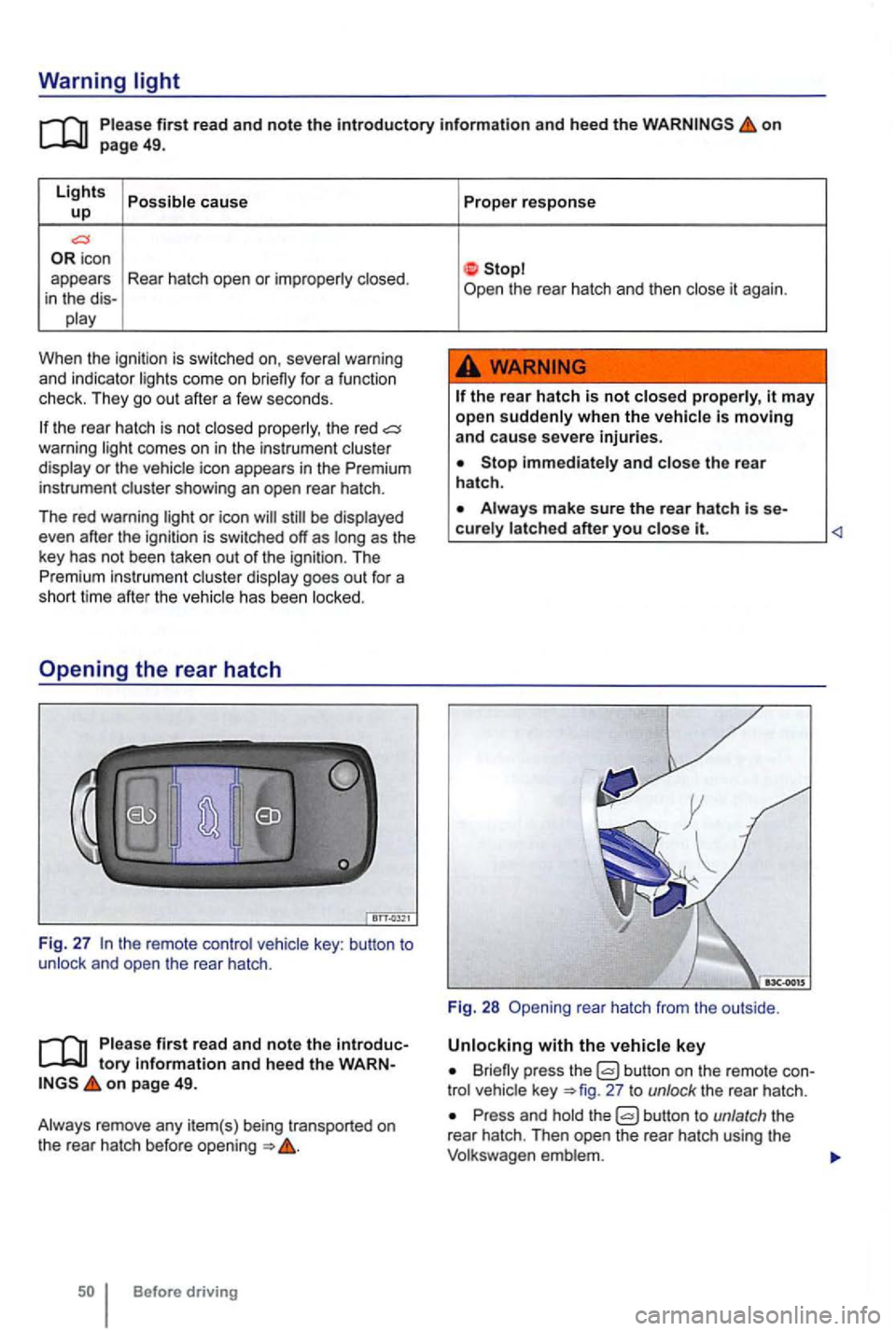
Warning light
first read and note the introductory information and heed the on page 49.
Lights cause up
icon
appears Rear hatch open or
When the ignitio n is swi tc hed on,
the rear hatch is no t the red comes on in the instrum ent or the icon appears in the Premium
instrument
be
has been
key : button to and open the rear hatch .
first read and note the tory informa tion and heed the on page 49.
Before driving Proper
response
the
rear hatch is not it may
open when the
Stop and the rear
hatch .
it.
Fig. 28 rea r hatch from the outside .
Briefly press the button on the remote 27 to unlock the rear hatch .
Press and the
Page 157 of 516
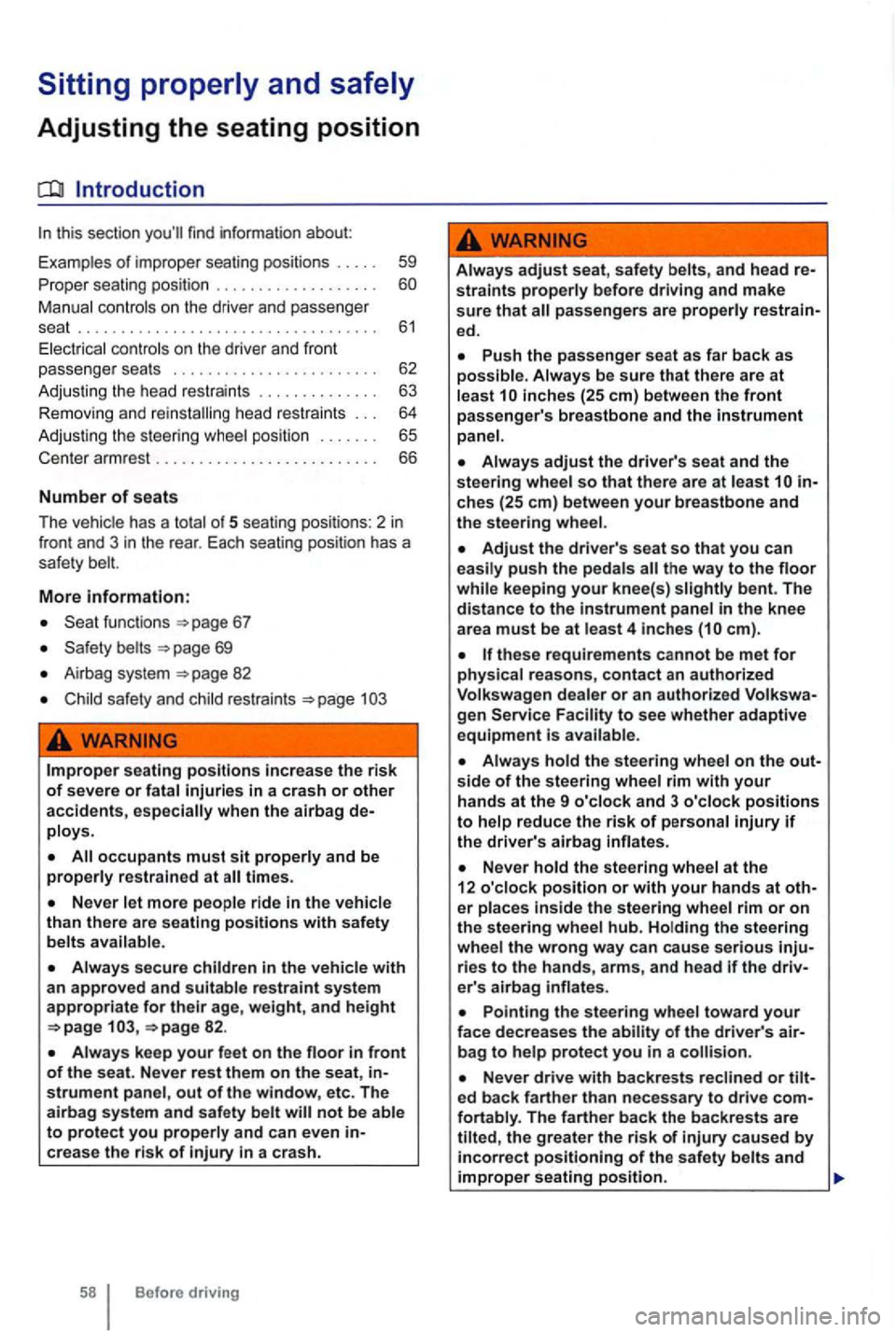
Adjusting the seating position
Introduction
this section find inf ormation about:
Examp les
of improper seat ing pos itions . . . 59
Pr ope r seating position . . . . . . . . . . . . .
Manual contr ols on the driver and passe nger
seat . . . . . . . . . . . . . . . . . . . . . . . . . . . . . . . . . . . 61 Ele ctrica l co ntr ols o n the driver and front
passenger seats . . . . . . . . . . . . . . . . . . . . . . . . 62
Adj ustin g
the head restra ints . . . . . . . . . . . . . 63
R emoving and re in stalling head restraints . . . 64
Adj usting the stee
ring whee l position . . . . . . . 65
Cen te r armrest . . . . . . . . . . . . . . . . . . . . . . . . . . 66
Number of seats
Th e vehicle
has a t otal of 5 seat ing posit ions: 2 in front and 3 in the rea r. Eac h seating pos ition has a
safety belt.
More information:
funct ions 67
page 69
Ai r ba g syste m 82
safety and child restraints
WARNING
Improper seat ing pos itions increase the risk of severe or fatal injuries in a crash or other accidents,
times .
Never
Always secure children in the vehicle with a n approved and suitable restraint system appropriate for their age, weight, and height 82 .
Always keep your feet on the in front of the seat. Never rest them on the seat,
Always adjust seat , safety belts, and head straints properly before driving and make sure that
inches (25 em) betw een the front pa ssenger' s breastbone and the in strument panel.
ches (25 em) between your breastbone and the steering wheel.
Adjust the driver's seat so that you can push the pedals while keeping your knee(s) slightly bent. The
di stance to the instrument panel in the knee
a rea must be at least 4 inche s
these requirements cannot be met for physical reason s, contact an authorized
Volk swagen dealer or an auth orized gen Facility to see whether adaptive equipment is avai la bl e.
Always hold the steering wheel on the side of the steering wheel rim with your hands at the 9 o'clock and 3 o'clock positions to help reduce the risk of personal injury if the driver's airbag inflates .
Never hold the steering whee l a t the
12 o'clock position or with your hands at e r places inside the steering whee l rim or on the steering wheel hub. Holding the steering wheel the wrong way can cause serious rie s to the hand s, arm s, and head if the
Pointing the steer ing whe el t oward your face dec reases the of the driver's bag to h elp protect you in a
Never drive with backrest s reclined or ed back farthe r than necessary to drive
Page 169 of 516
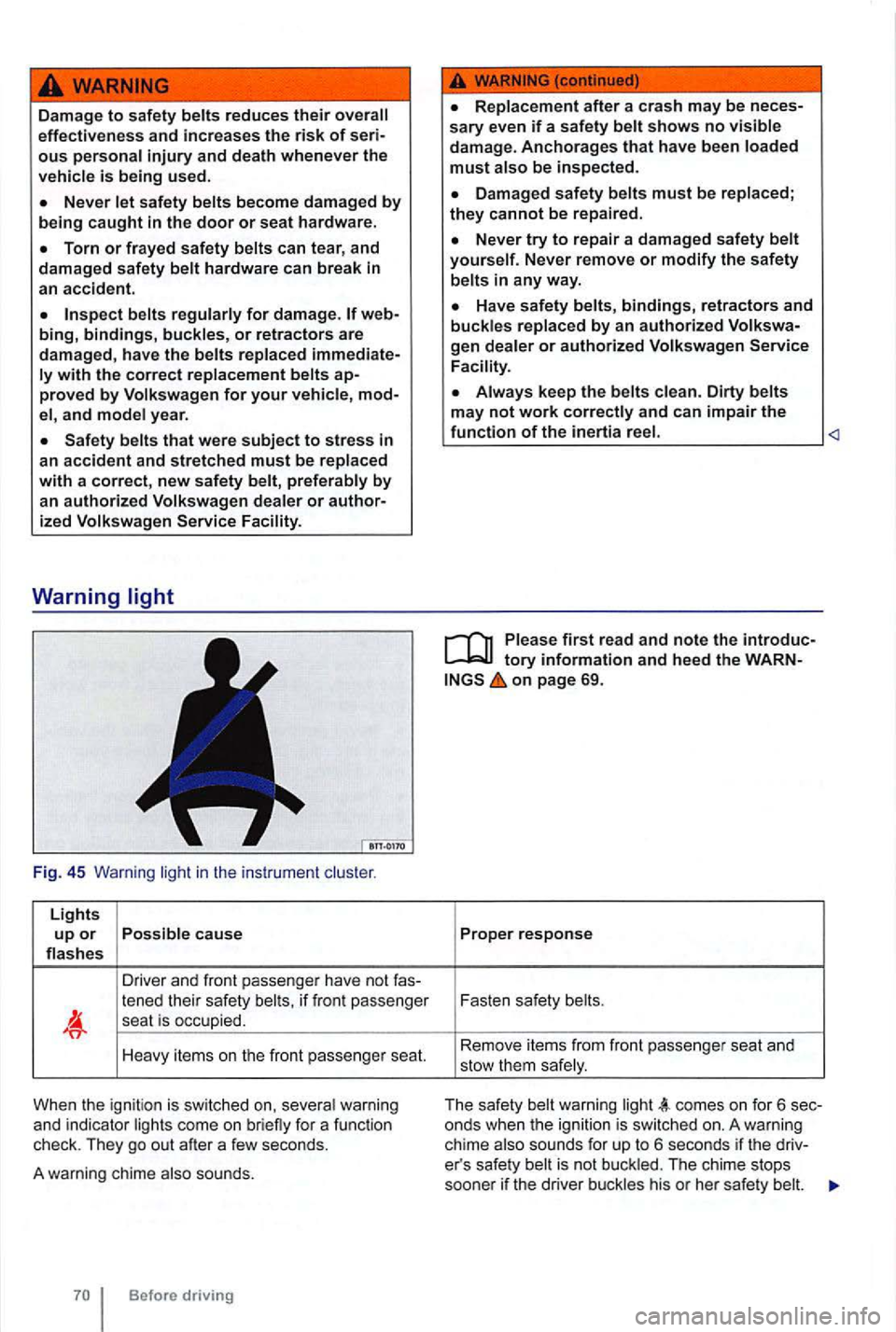
Damage to safety belts re duces their effective ne ss and increa ses the risk of serious personal injury and death whenever the
v ehicle is being used.
Torn or frayed safety belts can te ar, and
damag ed safety belt hardware can break
web
bing, bindings, buc kles, or retractors are damaged , hav e the belts replaced immediate
ly with the correct replacement belts proved by Volkswagen for your vehicle, model , and model yea r.
Fig . 45 Warning light in the instrume nt
Lights up or Possible caus e flas hes
Driver and front p asse nge r have not
tened their safety belts, if fr o nt passenger sea t is occup ied.
Heavy items on the front passe nge r seat.
Whe n the ign itio n is switched on, seve ra l warni ng
and indica tor lights come on brie fly for a func tion
check. They go out after a few seconds.
A warning chime also sounds.
Replacement after a crash may be neces
s ary even if a sa fety belt shows no visible damag e. Anchorages that have been loaded must also be inspect ed .
D amaged safety belts must be replaced ; they cannot be repaired .
Never try to repair a dam ag ed s afety belt yourself. Never remove or modify the safety
belts in any way.
Have safety belts, bindings, retractors and buckles replaced by an authorized
Always keep the belts clean . Dirty belts
may not work
tory information and heed the WARNon page 69.
Proper response
Fasten safety belts .
Re move it e m s f
rom fr ont passe nger seat and
stow them safe ly .
T
he safety belt wa rnin g light comes on f or 6 sec
onds when the ignition is sw itched on. A warning
ch ime also sounds for up to 6 seco nds if the driver's safe ty belt is not bu ckl ed . Th e c hime stops
soone r if the driver buckles his or her safe ty be lt.
Page 170 of 516
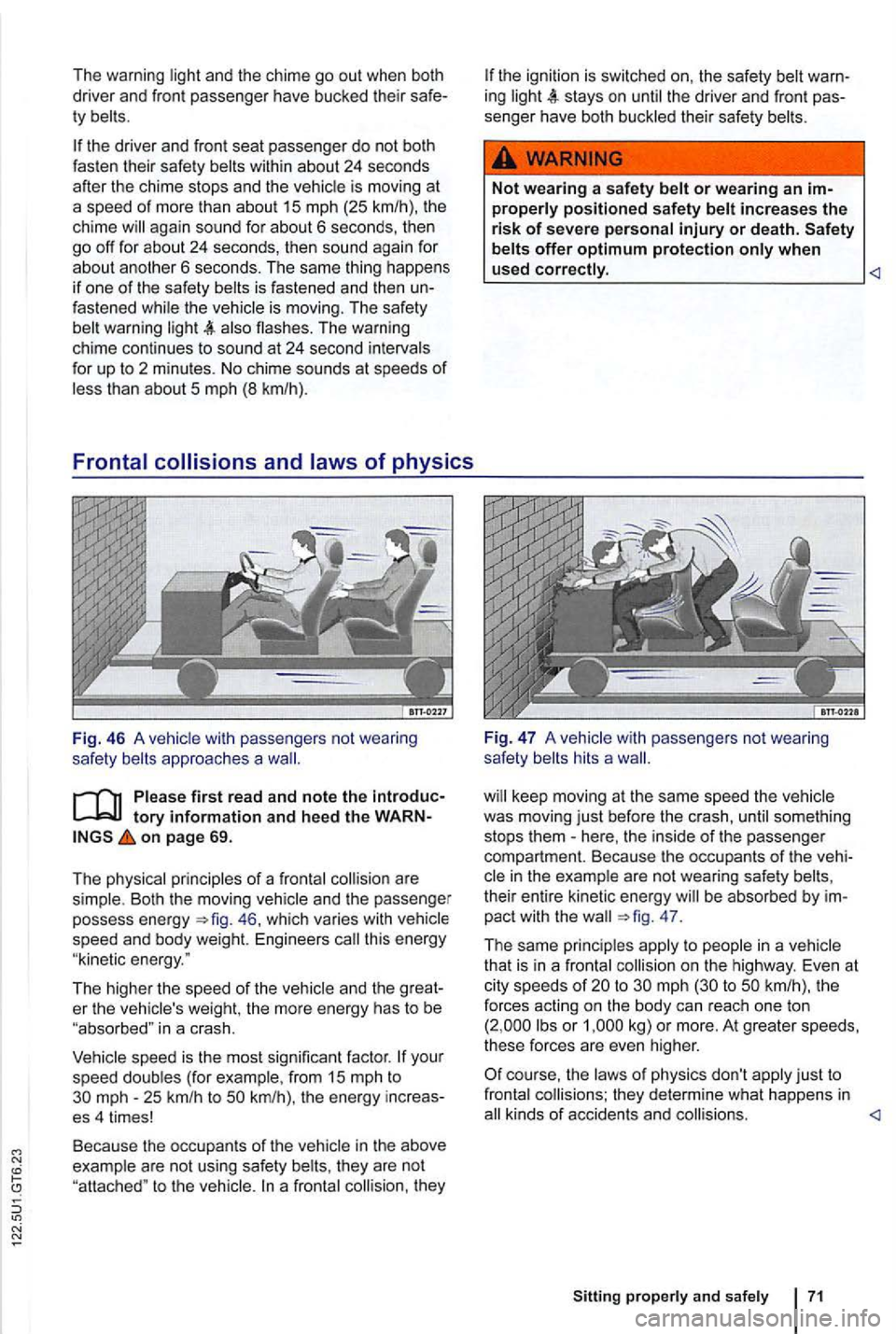
and the chime go out when both
driver and f ront passenger have bucked their ty
again sound for about 6 seconds, then go off for abo ut 24 seconds, then sound aga in for about anolher 6 seconds. The same thing happens
i f one of the safety fastened warning
of physics
Fig. 46 A vehicle with passengers not wearing safety
on page 69.
The physical principles of a frontal are
s imple . Both the moving vehicle and the passenger
possess energy 46, which varies with
er the vehicle 's weight, th e more energy h as to be "abso rbed" in a c rash.
speed is the most significan t factor .
they are not "attached " to the
increases the risk of severe personal injury or death.
with passengers not wea ring
safety
keep moving at the same speed the ve hicle was moving just befo re the cras h,
in the example are not wearing safety their entire kinetic energy pact with the 47.
The same principles on the highway. Even at
c ity speeds of 20 to 30 mph (30 to 50 km/h), the
fo rces acting on the body can reach one ton
(2 ,000 o r kg) or more. At greater speeds,
these forces are even higher.
of physics don't j ust to frontal they determine what happens in kinds of accidents and
Page 178 of 516
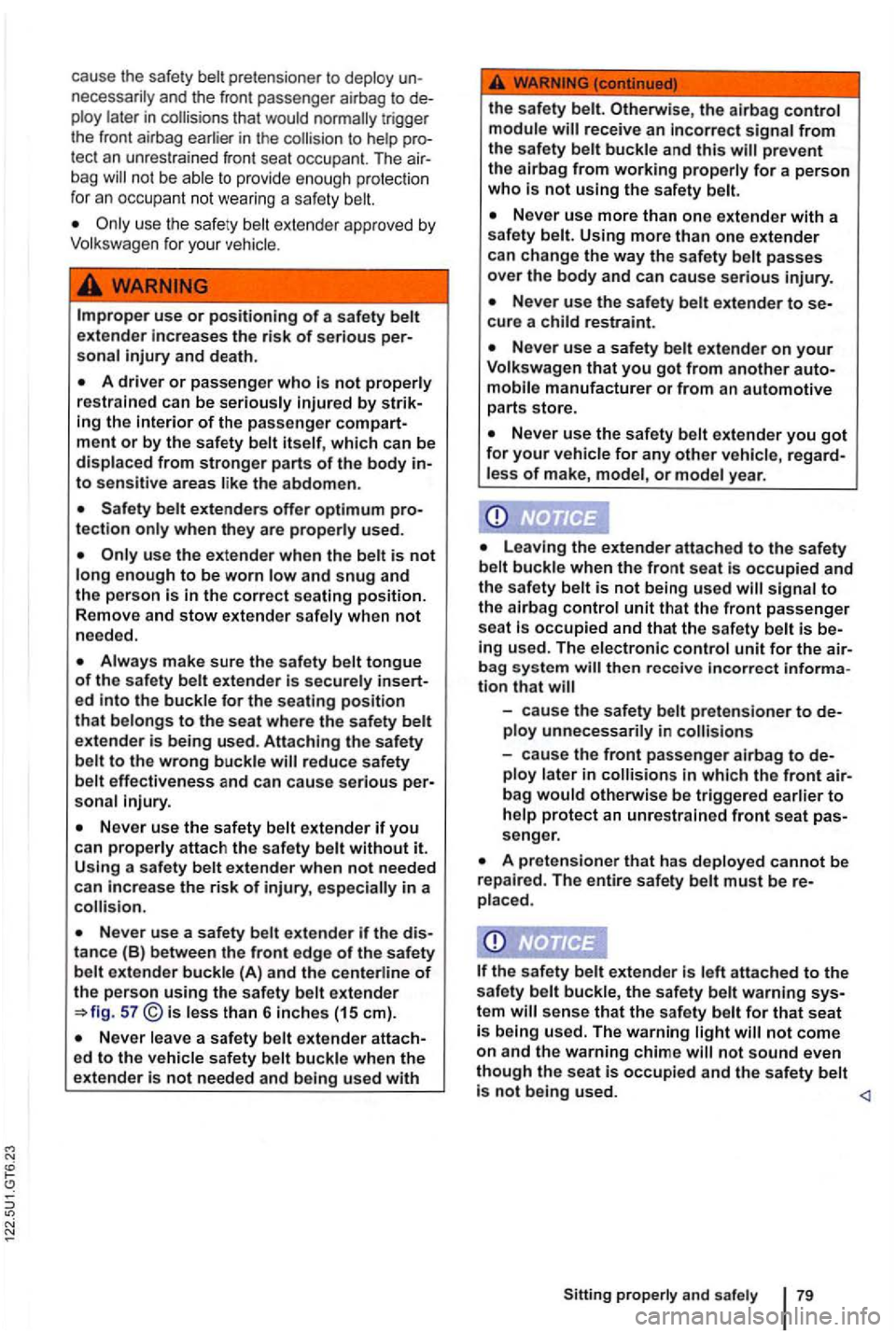
cause the safe ty belt pretensioner to deploy u n
necessar ily and the front passe nger airbag to de
p loy late r in that would
not be ab le to p rovi de enou gh pro tection
f or an occupant not wearing a safety be lt.
use t he safe ty b elt ex te n de r app ro ved by Volkswage n for your veh ic le .
Im
proper use or positioning of a safety belt extender increases the risk of serious per
sonal injury and death .
A driver or passenger who is not properly restrained can be seriously Injured by strik
Safety belt extenders offer optimum protection only when they are properly used.
use th e ex te nder when the belt is not tong enough to be worn tow and snug a.n.d the person the correct seating
Always make sure the safety belt tongue of the safety belt extender the buckle for the seating position that belongs to the seat where the safety belt extender is being used. Attaching the safety belt to the wrong buckle will reduce safety
belt effectiveness and can cause serious per
sona l injury.
Never use a safety belt extender if the distance (B) between the front edge of the safety belt extender buckle (A) and the centerline of the person using the safety belt extende r less than 6 inches (15 em).
Never leave a safety belt extender attached to the vehicle safety belt buckle when the
extender is not needed and being used with the
safety belt.
the airbag control module will receive an incorrect signal from the safety belt buckle and this will prevent
the alrbag from working properly for a person who is not usi ng the safe ty belt.
Never use the safety belt extender to se
cure a child restraint.
Never use the safet y belt extender you got for your vehicle for any other vehicle, regardless of make, model, or model year.
beused. The elect ronic control unit for the air
bag system will then receive incorrect informa
tion that will
- cause the safety belt pretensioner to deploy unnecessarily in collisions
-cause the fron t passenger alrbag to deploy la ter in collisions
A pretens ioner that has deployed cannot be
repaired . The entire safety belt must be re
placed .
being used. The warning